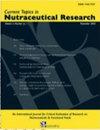大蒜在慢性肾脏疾病中的作用综述
IF 0.4
4区 医学
Q4 NUTRITION & DIETETICS
Current Topics in Nutraceutical Research
Pub Date : 2023-05-02
DOI:10.37290/ctnr2641-452x.21:194-197
引用次数: 0
摘要
慢性肾脏疾病的特征是尿功能持续异常、结构异常或排泄功能受损,这表明功能性肾单位的丧失。心血管疾病和死亡是慢性肾脏疾病最常见的并发症。一旦确定患有慢性肾病,治疗已被证明是无效的。因此,研究工作应致力于揭示早期疾病机制和替代治疗方案。传统上,大蒜除了作为食品调味剂外,还被用作药理学剂,尤其是在陈年后。研究表明,大蒜具有抗炎和免疫调节的特性。大蒜对肾功能的影响已经在细胞培养、动物和临床研究中得到了总结。本文章由计算机程序翻译,如有差异,请以英文原文为准。
Role of Garlic (Allium Sativum L.) in Chronic Kidney Diseases: A Short Review
Chronic kidney disease is characterized by persistent abnormalities in urinary function, structural abnormalities, or impaired excretory functions that indicate the loss of functional nephrons. Cardiovascular disease and death are the most common complications of chronic kidney disease. Once chronic kidney disease is established, treatment has proven ineffective. Therefore, research efforts should be devoted to uncovering early disease mechanisms and alternative treatment options. Traditionally, garlic has been used as a pharmacological agent, especially when aged, in addition to its application as a food flavoring agent. Studies have suggested that garlic has anti-inflammatory and immunomodulatory properties. The effects of garlic on renal function have been summarized in cell culture, animal, and clinical studies.
求助全文
通过发布文献求助,成功后即可免费获取论文全文。
去求助
来源期刊
CiteScore
1.10
自引率
0.00%
发文量
36
审稿时长
>12 weeks
期刊介绍:
Current Topics in Nutraceutical Research is an international, interdisciplinary broad-based peer reviewed scientific journal for critical evaluation of research on chemistry, biology and therapeutic applications of nutraceuticals and functional foods. The major goal of this journal is to provide peer reviewed unbiased scientific data to the decision makers in the nutraceutical and food industry to help make informed choices about development of new products.
To this end, the journal will publish two types of review articles. First, a review of preclinical research data coming largely from animal, cell culture and other experimental models. Such data will provide basis for future product development and/or human research initiatives. Second, a critical evaluation of current human experimental data to help market and deliver the product for medically proven use. This journal will also serve as a forum for nutritionists, internists, neurologists, psychiatrists, and all those interested in preventive medicine.
The common denominator of all of the topic to be covered by the journal must include nutraceuticals and/functional food. The following is an example of some specific areas that may be of interest to the journal. i) Role of vitamins, minerals, antioxidants and phytonutrients on cardiovascular health, cancer, diabetes, ocular health, mental health, men’s health, women’s health, infant nutrition, ii) Role of herbals on human health, iii) Dietary supplements and sleep, iv) Components of diet that may have beneficial effect on human health, v) regulation of apoptosis and cell viability, vi) Isolation and characterization of bioactive components from functional foods, vii) Nutritional genomics, and viii) Nutritional proteomics.

 求助内容:
求助内容: 应助结果提醒方式:
应助结果提醒方式:


